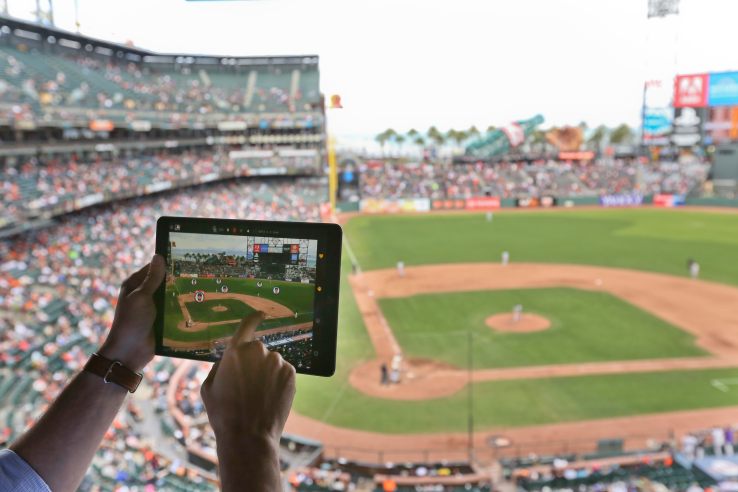How Major League Baseball is using Apple’s ARKit to increase fan engagement – TechCrunch

Last week, I slipped away from Disrupt for a couple of hours to watch a Giants game at nearby AT&T park — or, more precisely, watch a Giants game through an iPad. It was a small gathering hosted by Major League Baseball that points toward a possible future for fandom that’s exciting and fascinating, all while bringing out the crotchety old tech journalist in me that’s hidden not too far below the surface.
It’s a strange experience, and one that could lay the groundwork for a future in which stadium seats are full of spectators holding up iPad and iPhones. Though, unlike many of today’s smartphone sporting audience members, the forthcoming ARKit enabled update has the potential increase engagement, offering up contextual information to give users a deeper understanding of the game.
Baseball is the perfected candidate for this kind of augmented reality experience for two reasons. First, there’s a lot of downtime — even the staunchest of baseball apologists will cop to the fact that the game can be extremely slow. Second, baseball is a game of stats. From the baseball cards we collected as kids to the explosion of Sabermetrics/moneyball over the past decade, numbers are fundamentally important to the modern game.
MLB was showing the feature off in an early beta. The league is still very much in the testing phases, and this early press preview was the first time it’s really demoed the thing outside its own staff. In essence, it’s a bit like watching TV broadcast in person, with information overlaid on the action as it happens in real-time. The data is gathered from Statcast, MLB’s in-house analytics tool.
Statcast is available in all 30 major league parks — it’s a sort of big, black box that houses cameras and sensors that capture all of the on-field action at high speeds. It’s a been a pretty major boon for stats nerds, allowing fans to drill down on all sorts of fascinating minutiae, including things like launch angle and exit velocity for batted balls. Like sabermetrics before it, statcast has offered a new level of insight into the game that goes well beyond the batting average and ERA numbers that have long graced the backs of baseball cards.
Given the share amount of data currently available for any given play, AR implementation is a bit of a balancing act. You want to maximum the information offered up without completely obscuring the action. The rough demo MLB showed off last week seemed like a solid start. Like a television broadcast, much of the relevant data is displayed on a sort of chyron at the bottom of the screen, so as to not block the field.
Players on the field, meanwhile, get small, square popups featuring their faces that can be tapped open to offer up personalized player information. Statcast is already set up to identify players without the use of beacons, based on things like field positioning, so it’s perfectly set up to offer up this sort of information. The app also traces hit paths, while higgling their velocity. The version we looked at was still a bit buggy, but the idea came across pretty clearly.
Over the coming months and years, we’re going to see an AR land rush. Every company is going to demand some kind of augmented reality layer in their app, and most are going to be AR for AR’s sake. But like Ikea before it, MLB’s implementation makes perfect sense. Augmented reality enhanced the At Bat’s core purpose and leverages Statcast in a clever and interesting way.
What’s more up in the air, however, is what this means for the future of live games. It’s no surprise that MLB is embracing technology to engage a younger portion of its audience — baseball fans have, after all, been aging out. But it’s hard to shake the feeling that this points to a future where every single fan in the stands is watching a game through a smartphone or tablet.
“People are already using their phones, and we don’t think this is all that different,” MLB Product VP Chad Evans told us at the event. Of course, in a sport where small spherical objects are regularly projected into the stands at high speeds, it’s a good idea to keep your eye on the field. Perhaps popping up an alert on screen when a ball approaches would be a good start.
What’s interesting about this implementation, however, is that it simultaneously puts the focus on the device while increasing engagement with what’s happening on field. In a sport that relies on racing president mascots to keep fans interested, augmented reality could go a ways toward increasing focus on the game itself. And it could serve as a good way to get new fans up to speed, so you don’t find yourself constantly explaining every aspect to the significant other you dragged along with you.
There will some interesting challenges, too. MLB reps have already tested the tech in three locations, Dodgers Stadium, Oakland Coliseum and AT&T Park, where we caught the game (all notably in California). With 30 teams in the league, each location could present some interesting problems, based on vastly different geographic features — Fenway’s massive Green Monster comes to mind. Not to mention the number of different vantage points at each field — Dodgers Stadium, for example, has 56,000 seats — and you’re going to need the app to work perfectly in each one.
Hopefully MLB will get all of those kinks worked out in time for next season. The stands are going to be filled with people looking at their mobile device regardless of what occurs — so they may as well be using them to actually watch the ball game.



